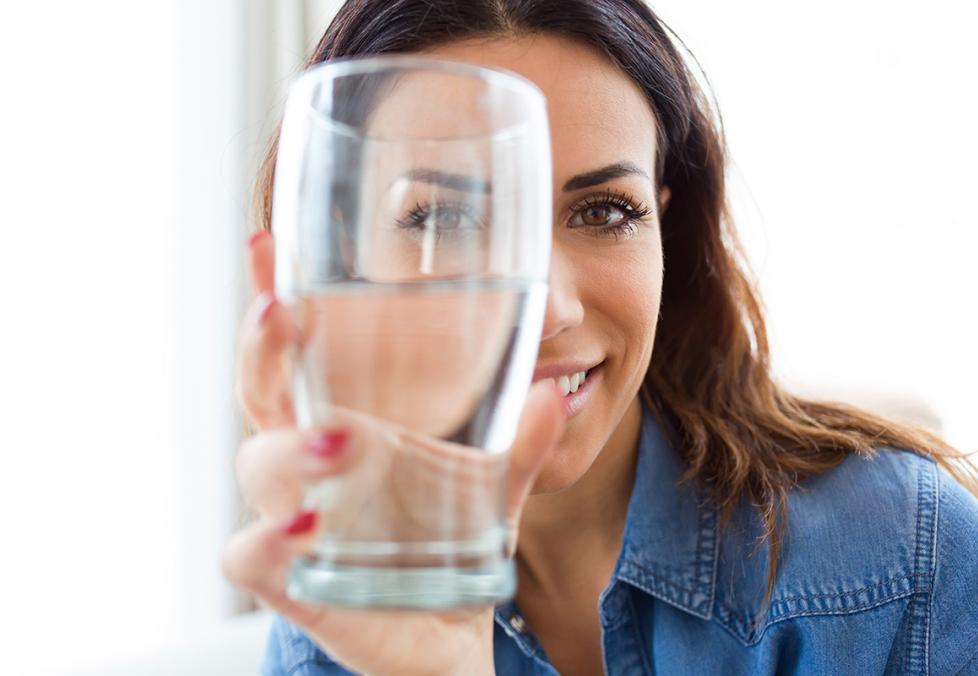
Today, what's good for your eyes is also good for the planet. Discover the frames, contacts, and practices that are lowering our environmental impact.
Everything you need to know to take care of your eyes — for life.
Dry eye affects some 16 million Americans. What’s one incredibly simple thing you can do to not be one of them? Drink up.

You probably feel it in your mouth first: that parched, need-a-sip-of-water sensation that signals your body is thirsty. But your mouth is hardly the only place that requires proper hydration. Getting enough fluids is essential to keeping all your bodily functions working smoothly — from regulating your body temperature and fighting off infections to keeping your organs functioning properly. And that includes your eyes.
Research shows that hydration plays an important role in eye health. Scientists found that people who were shortchanging their thirst were more likely to suffer from dry eye than people who were well-hydrated. That’s according to the journal Investigative Ophthalmology and Visual Science.
“Often, people’s eyes will water if their eyes are dry, and they think they have too much hydration,” says Robert Simon, O.D. He’s an optometrist at Nashville Regional Eye Care, located within America’s Best Contacts & Eyeglasses. But the opposite may be true. And left unchecked, dry eye can put you at greater risk of serious problems, such as corneal abrasions and eye inflammation.
Have questions about your vision or eye health? Reach out to your America’s Best optometrist, who’s an important part of your care team. Click here to make an appointment.
Here’s what you should know about the importance of staying hydrated.
Roughly 60% of the human adult body is water. But the amount of water in any part of your body — and the role it plays — can vary. Bones, for instance, are made up of about 31% water. But the brain is closer to 73% water, as it’s needed to manufacture hormones and neurotransmitters. Plus, water acts as a shock absorber for your brain.
In the eye, water helps your tear production hum along properly. Your tears, after all, aren’t just an emotional signal. They’re crucial to repelling bacteria and protecting the cornea. And — coming full circle here — your tears keep the surface of your eye moist and healthy.
Your eyes make three types of tears, according to the American Academy of Ophthalmology.
Basal tears. These tears are in your eyes all the time, acting as a barrier between your delicate cornea and the dirt and debris of the outside world, explains Dr. Simon. Every time you blink, these tears spread across the surface of the eye and eventually drain into tiny holes near the corners of your eyelids.
If you’re dehydrated, these tears will be affected. With “thirsty” eyes, you may notice a burning sensation. That’s a classic dry eye symptom.
Reflex tears. These tears appear when dust, dirt, or other foreign objects get into your eye.
Emotional tears. The eye-welling wetness that happens when you watch a sad movie? These are the emotional tears at work.
If you experience dry eye, it probably means the glands that produce and secrete your basal tears are not functioning correctly, says Dr. Simon. The main drivers of dry eye include heavy screen use without interruption, medication side effects, eyelid inflammation, and natural age-related hormone fluctuations. But dehydration is also a factor. (For more common culprits, check out “6 Things Your Dry Eyes Are Trying to Tell You” here.)

Today, what's good for your eyes is also good for the planet. Discover the frames, contacts, and practices that are lowering our environmental impact.
Remember that study above, in which well-hydrated people were less likely to report symptoms of dry eye? One of the recommendations to relieve and prevent symptoms was to … stay hydrated. But what does that mean exactly?
Hydration is an incredibly personal thing. Exercising, living in a hot climate, and certain medications may increase your hydration needs. In fact, there’s no hard-and-fast rule about how much water everyone should drink.
Current U.S. dietary guidelines don’t include hydration goals. And the eight-cups-a-day advice that many of us aim for can be traced back to a 1945 Food and Nutrition Board recommendation. It suggested that people need about 2.5 liters of water a day to thrive. But the authors pointed out that much of that moisture could come from food, rather than drinks. That means a diet rich in brothy soups, creamy yogurt, or juicy watermelon may be just as effective as sipping water.
Rather than obsess over how many ounces you drink, follow your thirst cues. Nutrition experts recommend keeping a bottle of water nearby so that you can take sips throughout the day as needed. And make a point of drinking a glass of water with every meal.
Most important, stay alert to the warning signs of dehydration:
Dry eye probably won’t be the first and only clue that you’re dehydrated, but it’s a sign that you might need to make some sort of adjustment, Dr. Simon says.
“Dry eye starts out as mild, but it gets worse if not addressed properly,” he says. Corneal thinning, for instance, is relatively rare, but it can occur when dry eyes are left untreated — and it requires surgery to correct.
Talk to your eye doctor if you feel hydrated but still struggle with dry eye. They can rule out a more serious condition. They may also recommend over-the-counter or prescription eyedrops to bring relief and help keep your eyes moist.